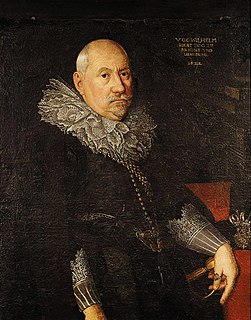
Albert II was the Margrave of Brandenburg-Kulmbach (Brandenburg-Bayreuth) from 1527 to 1553. He was a member of the Franconian branch of the House of Hohenzollern. Because of his bellicose nature, Albert was given the cognomen Bellator during his lifetime. Posthumously, he became known as Alcibiades.

Albert of Prussia was a German nobleman who was the 37th Grand Master of the Teutonic Knights, who after converting to Lutheranism, became the first ruler of the Duchy of Prussia, the secularized state that emerged from the former Monastic State of the Teutonic Knights. Albert was the first European ruler to establish Lutheranism, and thus Protestantism, as the official state religion of his lands. He proved instrumental in the political spread of Protestantism in its early stage, ruling the Prussian lands for nearly six decades (1510–1568).

Frederick I of Ansbach and Bayreuth was born at Ansbach as the eldest son of Albert III, Margrave of Brandenburg by his second wife Anna, daughter of Frederick II, Elector of Saxony. His elder half-brother was the Elector Johann Cicero of Brandenburg. Friedrich succeeded his father as Margrave of Ansbach in 1486 and his younger brother Siegmund as Margrave of Bayreuth in 1495.

George Frederick of Brandenburg-Ansbach was Margrave of Ansbach and Bayreuth, as well as Regent of Prussia. He was the son of George, Margrave of Brandenburg-Ansbach and a member of the House of Hohenzollern. He married firstly, in 1559, Elisabeth of Brandenburg-Küstrin. He married secondly, in 1579, Sophie of Brunswick-Lüneburg, daughter of William of Brunswick-Lüneburg and Dorothea of Denmark.

George of Brandenburg-Ansbach, known as George the Pious, was a Margrave of Brandenburg-Ansbach from the House of Hohenzollern.

The House of Hohenzollern is a former German royal dynasty whose members were variously princes, electors, kings and emperors of Hohenzollern, Brandenburg, Prussia, the German Empire, and Romania. The family came from the area around the town of Hechingen in Swabia during the late 11th-century and took their name from Hohenzollern Castle. The first ancestors of the Hohenzollerns were mentioned in 1061.

John George of Brandenburg was a prince-elector of the Margraviate of Brandenburg (1571–1598).

Gottfried Heinrich Graf zu Pappenheim was a field marshal of the Holy Roman Empire in the Thirty Years' War.

The Principality of Bayreuth or Margraviate of Brandenburg-Bayreuth was an immediate territory of the Holy Roman Empire, ruled by a Franconian branch of the Hohenzollern dynasty. Since Burgrave Frederick VI of Nuremberg was enfeoffed with the Margraviate of Brandenburg in 1415/17, the Hohenzollern princes transferred the margravial title to their Franconian possessions, though the principality never had been a march. Until 1604 they used Plassenburg Castle in Kulmbach as their residence, hence their territory was officially called the Principality of Kulmbach or Margraviate of Brandenburg-Kulmbach until the Empire's dissolution in 1806.
Pappenheim was a German statelet in western Bavaria, Germany, located on the Altmühl river between Treuchtlingen and Solnhofen, and south of Weißenburg. As former sovereign family, later mediatized to Bavaria in 1806 the family belongs to High nobility.

William, called William the Younger, was Duke of Brunswick-Lüneburg and Prince of Lüneburg from 1559 until his death. Until 1569 he ruled together with his brother, Henry of Dannenberg.

Albert II or V of Brandenburg-Ansbach was a German prince, who was Margrave of Ansbach from 1634 until his death.
Henry V of Plauen was Burgrave of Meissen and Lord of Plauen and Voigtsberg.

Henry IV of Plauen, was Colonel Chancellor of the Kingdom of Bohemia, Burgrave of Meissen, Lord of Plauen, Gera, Greiz, Schleiz and Bad Lobenstein, Lord of Toužim, Hartenštejn Castle, Andělská Hora Castle and Žlutice. He also used the traditional title of Lord of Lázně Kynžvart and, apart from an intermezzo in 1547, he was Lord of Bečov nad Teplou as well.
Barbara of Brandenburg-Ansbach-Kulmbach was a princess of Brandenburg-Ansbach by birth and marriage Landgravine of Leuchtenberg.
Pappenheim-Alesheim was a statelet in the Holy Roman Empire that existed from 1444 until 1697.
Pappenheim-Schwindegg was a statelet in the Holy Roman Empire that existed from 1518 until 1568.
Pappenheim-Allgäu was a statelet in the Holy Roman Empire that existed from 1444 until it was partitioned in 1494.











